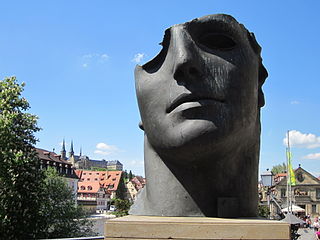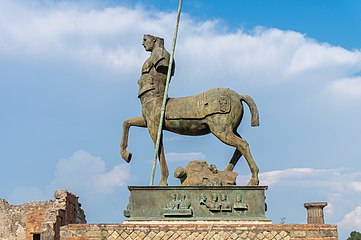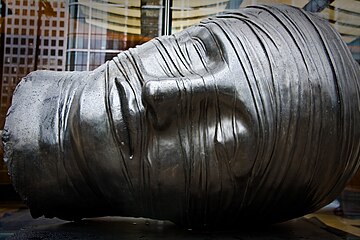Igor Mitoraj
Igor Mitoraj | |
|---|---|
Kraków Academy of Art | |
| Known for | Sculptor |
| Notable work | Luci di Nara Eros Bendato Héros de Lumière |
Igor Mitoraj (Polish pronunciation: [ˈiɡɔr miˈtɔraj]; 26 March 1944 – 6 October 2014) was a Polish artist and sculptor.[1] Known for his fragmented sculptures of the human body often created for large-scale public installations, he is considered one of the most internationally recognized Polish sculptors.[2][3]
Biography
Mitoraj was born on 26 March 1944 in
to continue his studies at the National School of Art.Shortly afterwards, he became fascinated by Latin American art and culture, spending a year painting and travelling around Mexico. The experience led him to take up sculpture.
He returned to Paris in 1974 and two years later he held another major solo exhibition at the Gallery La Hune, including some sculptural work. The success of the show persuaded him that he was first and foremost a sculptor.
Having previously worked with terracotta and bronze, a trip to Carrara, Italy, in 1979 turned him to using marble as his primary medium and in 1983 he set up a studio in Pietrasanta. In 2006, he created the new bronze doors and a statue of John the Baptist for the basilica of Santa Maria degli Angeli in Rome.
In 2003, he returned to Poland.
In 2005, he received the Golden Medal of
In 2016, Mitoraj's works were exhibited in Pompei, Italy. The Italian culture minister Stefano Contini announced that the artist's sculpture entitled "Daedalus", would remain in Pompeii permanently as a gift to Italy.[8]
Style
Mitoraj's sculptural style is rooted in the
Gallery
-
Gambe Alate (bronze), 2002.
-
Héros de Lumière, Carrara marble (1986) at the Yorkshire Sculpture Park
-
Luci di Nara on the Beeld boulevard, Scheveningen, the Netherlands.
-
Centurione I, 1987, Bamberg, Germany.
-
Valle Dei Templi, Agrigento
-
Centauro, Forum of Pompeii, Pompeii, Italy.
-
Centurione I. 1987. Bronze. Columbus Courtyard, Canary Wharf, London.
-
Centauro. 1984. Bronze. Montgomery Square, Canary Wharf, London.
-
Testa Addormentata, bronze, 1983, located at Bank Street, outside West Wintergarden, Canary Wharf, London, Great Britain.
References
- ^ "Igor Mitoraj obituary". The Guardian. 17 October 2014.
- ^ "Igor Mitoraj". Retrieved 2020-05-06.
- ^ "Igor Mitoraj". Retrieved 2020-05-06.
- ISBN 978-83-88848-0-63.
- ^ Paltenghi, Barbara; Chiappini, Rudy (2002). Igor Mitoraj. Skira. p. 124.
- ^ wiadomości.wp.pl (2005-10-05). "Medal Gloria Artis dla twórców i działaczy kultury - Wiadomości - WP.PL". Wiadomosci.wp.pl. Archived from the original on 2013-10-03. Retrieved 2013-05-28.
- ^ "Odznaczenia z okazji Święta 3 Maja / Ordery i odznaczenia / Aktualności / Oficjalna strona Prezydenta Rzeczypospolitej Polskiej". Prezydent.pl. Archived from the original on 2013-09-13. Retrieved 2013-05-28.
- ^ "Polish sculptor's "Daedalus" a permanent addition to Pompeii". poland.pl. Retrieved 18 May 2023.
- ^ "With his mammoth sculptures of fragmented bodies expressing human suffering, Igor Mitoraj was in a class of his own". Retrieved 2019-09-21.
External links
- Emociones da Trajano. Video by Leandro Manuel Emede shot in Roma at Mercati di Traiano
- more pics of Mitoraj's sculptures
- (in Polish) Igor Mitoraj. Rzeźba i rysunek
- "Eros Tied in Krakow". Cracovia. October 2005. Archived from the original on October 21, 2007.
- Contini Art UK
- Igor Mitoraj at Art Gallery Katarzyna Napiórkowska in Poland[permanent dead link]










